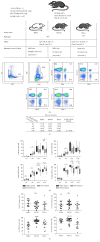Minor Antigen Disparities Impede Induction of Long Lasting Chimerism and Tolerance through Bone Marrow Transplantation with Costimulation Blockade
- PMID: 27872868
- PMCID: PMC5107841
- DOI: 10.1155/2016/8635721
Minor Antigen Disparities Impede Induction of Long Lasting Chimerism and Tolerance through Bone Marrow Transplantation with Costimulation Blockade
Abstract
Mixed chimerism and tolerance can be successfully induced in rodents through allogeneic bone marrow transplantation (BMT) with costimulation blockade (CB), but varying success rates have been reported with distinct models and protocols. We therefore investigated the impact of minor antigen disparities on the induction of mixed chimerism and tolerance. C57BL/6 (H2b) mice received nonmyeloablative total body irradiation (3 Gy), costimulation blockade (anti-CD40L mAb and CTLA4Ig), and 2 × 107 bone marrow cells (BMC) from either of three donor strains: Balb/c (H2d) (MHC plus multiple minor histocompatibility antigen (mHAg) mismatched), B10.D2 (H2d) or B10.A (H2a) (both MHC mismatched, but mHAg matched). Macrochimerism was followed over time by flow cytometry and tolerance was tested by skin grafting. 20 of 21 recipients of B10.D2 BMC but only 13 of 18 of Balb/c BMC and 13 of 20 of B10.A BMC developed stable long-term multilineage chimerism (p < 0.05 for each donor strain versus B10.D2). Significantly superior donor skin graft survival was observed in successfully established long-term chimeras after mHAg matched BMT compared to mHAg mismatched BMT (p < 0.05). Both minor and major antigen disparities pose a substantial barrier for the induction of chimerism while the maintenance of tolerance after nonmyeloablative BMT and costimulation blockade is negatively influenced by minor antigen disparities. .
Figures



Similar articles
-
Distinct roles for major and minor antigen barriers in chimerism-based tolerance under irradiation-free conditions.Am J Transplant. 2021 Mar;21(3):968-977. doi: 10.1111/ajt.16177. Epub 2020 Jul 24. Am J Transplant. 2021. PMID: 32633070 Free PMC article.
-
Induction of stable long-term mixed hematopoietic chimerism following nonmyeloablative conditioning with T cell-depleting antibodies, cyclophosphamide, and thymic irradiation leads to donor-specific in vitro and in vivo tolerance.Biol Blood Marrow Transplant. 2001;7(12):646-55. doi: 10.1053/bbmt.2001.v7.pm11787527. Biol Blood Marrow Transplant. 2001. PMID: 11787527
-
A nonlethal conditioning approach to achieve durable multilineage mixed chimerism and tolerance across major, minor, and hematopoietic histocompatibility barriers.J Immunol. 1995 Nov 1;155(9):4179-88. J Immunol. 1995. PMID: 7594573
-
Inducing mixed chimerism and transplantation tolerance through allogeneic bone marrow transplantation with costimulation blockade.Methods Mol Biol. 2007;380:391-403. doi: 10.1007/978-1-59745-395-0_25. Methods Mol Biol. 2007. PMID: 17876108 Review.
-
[Studies on the induction of transplantation tolerance and immune reconstitution through combined strategies].Beijing Da Xue Xue Bao Yi Xue Ban. 2007 Oct 18;39(5):547-9. Beijing Da Xue Xue Bao Yi Xue Ban. 2007. PMID: 17940578 Review. Chinese.
Cited by
-
Combining Adoptive Treg Transfer with Bone Marrow Transplantation for Transplantation Tolerance.Curr Transplant Rep. 2017;4(4):253-261. doi: 10.1007/s40472-017-0164-7. Epub 2017 Nov 4. Curr Transplant Rep. 2017. PMID: 29201599 Free PMC article. Review.
-
Distinct roles for major and minor antigen barriers in chimerism-based tolerance under irradiation-free conditions.Am J Transplant. 2021 Mar;21(3):968-977. doi: 10.1111/ajt.16177. Epub 2020 Jul 24. Am J Transplant. 2021. PMID: 32633070 Free PMC article.
-
Anti-Interleukin-6 Promotes Allogeneic Bone Marrow Engraftment and Prolonged Graft Survival in an Irradiation-Free Murine Transplant Model.Front Immunol. 2017 Jul 19;8:821. doi: 10.3389/fimmu.2017.00821. eCollection 2017. Front Immunol. 2017. PMID: 28769930 Free PMC article.
-
Murine models of transplantation tolerance through mixed chimerism: advances and roadblocks.Clin Exp Immunol. 2017 Aug;189(2):181-189. doi: 10.1111/cei.12976. Epub 2017 May 22. Clin Exp Immunol. 2017. PMID: 28395110 Free PMC article. Review.
References
MeSH terms
Substances
LinkOut - more resources
Full Text Sources
Other Literature Sources
Medical
Research Materials

